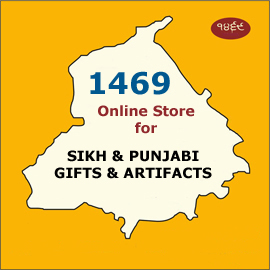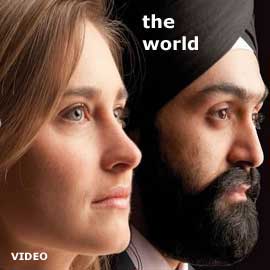Columnists
The True North
The Talking Stick Colloquium # 41, Ardaas (Conclusion)
Convenor: RAVINDER SINGH TANEJA
THIS WEEK - IN CONCLUSION
Our study of the Sikh ardaas concludes this week with a brief overview of the last section of our communal prayer.
Prayers or supplications are nuanced by their settings: personal prayers tend to be transactional in nature, usually inspired by some need or fear, occasionally by a sense of gratitude; communal prayers are submissions of a community's intent, a
narration of its history, a remembrance of its heroes and a political statement - all rolled into one.
The Sikh ardaas, however, can be an individual expression as well as the voice of an assembly of Sikhs. The free form of the concluding section (which follows, below) of the ardaas allows for customization to suit any occasion.
Hey nimaanyaa(n) dey maan
Nitaanyaa(n) dey taan
Ni-oatyaa(n) dee oat
Sacchey pita, Waheguru!
Aap dey huzoor ............ di ardaas hai ji
Akhkhar vaadha ghaata bhul chuk maaf karnee
Sarbat dey kaaraj raas karney
Se-yee piyaarey mel
Jinha milyaa(n) tera Naam chitt aavey
Nanak Naam chardi kalaa
Tere bhaaney sarbat da bhalla
"O Honor of the humble
Strength to the weak
Support to the helpless
Our true Father, Waheguru!
We submit to you our petition: ... (Free form to suit the occasion)
Forgive us errors of action and omission,
Aid us in fulfilling our purpose and responsibility,
Grant us the right company
In whose association - you are forever near.
Nanak pleads for the gift of
Naam, Hope, Goodwill and the welfare of Humanity."
LET'S PONDER TOGETHER - IN RETROSPECT
The Sikh ardaas is a literary masterpiece - a fact that we do not (at least, I did not) appreciate enough. The choice of words is so exact and precise, yet laden with meaning and open to successive interpretations - timeless.
More than its literary excellence, the aardas is also history and a eulogy, but beyond all this lies the central message that has deep social and political significance: we need to dwell carefully on each of its lists for their message and the ideas they convey to Sikhs in the twenty first century.
It seems to me that the ardaas - like the Guru Granth Sahib - is our moral, spiritual and political compass where True North is represented by the principles and ideas conveyed in its text - individual compassion, integrity, forgiveness, social equality,
justice and public welfare.
These ideas call for the cultivation of an impeccable personal code of conduct, a sense of civic responsibility and political activism.
The question for us as a community is to reflect on how well we are carrying forward the ideal of a 'Halemi Raj'?
Are we making a difference? Are we fighting for justice and equality? Do we speak up against exploitation - of women, children and the downtrodden? Do we take a stand?
On the issue of personal prayer, some issues, not surprisingly, remain.
To pray or not to pray - that is the question! Communal prayer can be (and is) part of the liturgy, but what about individual prayer?
1 If God knows everything (omniscient), then why bother?
2 If Hukam is immutable, how can an individual petition make a difference in changing it?
3 If an ardaas can fulfill all my desires, why should I make any effort or act?
4 Is it right - or beneficial - to pray in order to cover up one's failings and shortcomings?
5 Are we trying to bend Hukam to our own selfish interests, only to be disappointed when the desired outcome does not materialize?
6 Is prayer just a supplication or is it a path of spiritual growth, leading us from selfish begging to a sense of thanksgiving and gratitude expressed, not in words, but in deep silence?
December 20, 2010
Conversation about this article
1: Mohan Singh (Toronto, Ontario, Canada.), December 20, 2010, 10:19 PM.
At this point, Prof. Singh Sahib of the Guru Granth Sahib Academy has added the following line to his ardaas, and is in practice from early 2010: "Hay Akal Purakh, Patna Sahib attey Hazur Sahib attey kuchh hor Guru asthaana(n) te ho rahi Guru di be-adbee attey munn-mutt nu thhal paundi chetanta aytye agawaai aapne Khalsa panth nu bakhso ji" and then "Hey nimaanyaa(n) dey maan - Gurmat anusaar sarbat dey kaaraj raas karney". A few other pleas like "Bachiaa(n) nu maa-baap de aagyakari, ucch Vidya" ... etc. is also added. Prayer is ardaas and ardaas is prayer, a special moment of remembrance, submission that is a way of seeking Grace of Waheguru. Traditionally, every day several times, as Kabir ji said, "Kabir kayso kayso kookee-ai na so-ee-ai asaar/ raat divas kay kooknay kabhoo kay sunai pukaar." - Kabeer, chant the Name of the Lord; do not sleep unaware. Chanting His Name night and day, the Lord will eventually hear your call" - [GGS:1376]. As I mentioned earlier, here we seek strength, tolerance and courage to face the situation or circumstances and even Grace.
2: Balbir Singh (Germany), December 21, 2010, 7:49 AM.
Ardaas is not a composition agreed by some and repeated by millions. Ardaas is for ever-awareness of God's Will.
3: Bibek Singh (Jersey City, U.S.A.,), December 21, 2010, 10:43 PM.
The following article is worth reading -> http://www.singhsabhacanada.com/Articles/1003
4: Ravinder Singh Taneja (Westerville, Ohio, U.S.A.), December 22, 2010, 8:24 AM.
Part of my motivation has been to try and look beyond conventional explanations of gurbani, Sikh history and Sikh heritage. My approach to the ardaas was undertaken with a similar view. Personally, I am quite certain that the Sikh ardaas goes well beyond the usual petitioning (although it does that as well). To me, the ardaas is an encapsulation of our entire heritage. Reciting the ardaas gives us a vivid recollection of the panth's history, its images, its institutions and practices - lest we forget the values that the panth stands for and what we should inherit. I also see in the ardaas a political manifesto that outlines the ideal socio-political order. It is a pledge that we take to uphold these ideals and move the vision of the Gurus forward. Above all, it represents our resolve to achieve our goals - hence the slogan of victory (fateh, jaikara and dohira) at the end of the ardaas.
5: Ravinder Singh Taneja (Westerville, Ohio, U.S.A.), December 22, 2010, 3:57 PM.
Balbir Singh ji: you had asked, in one of your comments last week, if we need such a long list of demands. I wonder if you still think the ardaas is just a list of demands. I am inclined to believe that there isn't even room for any demand. At the bottom, the only petition is for the gift of Naam expressed variously - and that too because Naam is the outcome of Nadar. The theme around prayer (benti, ardaas) in the Guru Granth Sahib is similar: no personal demands but the gift of bhagti and Naam.
6: Mohan Singh (Toronto, Ontario, Canada.), December 22, 2010, 11:01 PM.
The term composition means 'putting together, and can apply to any thing from art or music to writing, that is arranged or put together using conscious thought. Nothing exists without composition. Awareness is the composition of consciousness, intelligence and sense. We are aware that God is within us, still we search Him in the outside world, and we even refer to Him being up in the sky. That is our intelligence and sense. As in the ardaas, Guru Granth Sahib is also a composition. Some time in 1979, the Prime Minister of India, Morarji Desai, once visited Darbar Sahib in Amritsar, and in addressing the SGPC, politicians and VIPs of the time. he said: Punjab is the land of Ten Guru Sahiban, Sants and Bhagats. There is a flow of Amrit Bani 24 hours a day all over Punjab. But I am sorry to say that consumption of liquor/ alcohol in Punjab is the highest in the country. There is a need to increase the awareness of the message of gurbani and God's Will. Even today the situation is the same, rather our politicians distribute free alcohol for votes. Guru Nanak traveled thousands of miles on foot to create awareness of ONE GOD, and words of God flowed through his mouth, which he described as dhur ki bani. Guru Nanak said: "Muhou ke bolan bolee-ai jit sun dharay pyaar" - 'What words can we speak to evoke His Love?' [GGS:3]. Guru Nanak also said: "Using a limited number of words, we try to describe the limitless True Lord" - [GGS:934]. Again: "With faith in the Name, intuitive awareness wells up; through the Name, intelligence comes" - [GGS:1242].
7: Mohan Singh (Toronto, Ontario, Canada.), December 23, 2010, 7:28 PM.
Gurbani says: 'Birthi kade naa hovai jan ki ardaas' - [GGS:819]. One can say niji (personal) ardaas for chardi kalaa, health, naam daan, etc. from the bottom of the heart, and surrender to God. Guru Arjan also did niji ardaas for the well being of his son Hargobind, and upon fulfillment he said words of shukrana (gratitude).
8: Balbir Singh (Germany), December 24, 2010, 8:41 AM.
Please read this as a comment to post #5 by S. Ravinder Singh ji. Naam is the outcome of Nadar. One can realize this only after receiving Naam ... Normally the list is longer than the sentences in the inserted ardaas.
9: Balbir Singh (Germany), December 24, 2010, 10:28 AM.
Naam is enough to be one with God. Also, one true Naam is spoken, when His love is evoked. One cannot learn to do true prayer. Prayer happens.
10: Ravinder Singh Taneja (Westerville, Ohio, U.S.A.), December 24, 2010, 10:42 AM.
I would concur with you, Balbir Singh ji, that normally the list of demands is a long one. In our present discussion, the focus is obviously on our congregational or community prayer - less on individual prayer. To my mind, individual prayer can be more flexible and fluid.
11: Veronica Sidhu (Scotch Plains, New Jersey, U.S.A.), December 24, 2010, 6:19 PM.
Thank you for expounding this masterpiece - and for these wonderful questions that I have been "sitting with" for many years. Prayer to me is like a lens. And just as a lens concentrates the rays of the sun that are throughout the sky, prayer focuses our relationship to the divine which is always present, but thusly tuning us to a higher vibration. All prayer will raise us. The prayer to be one with His Will in His service will raise us ever higher.
12: Mohan Singh (Toronto, Ontario, Canada.), December 24, 2010, 7:01 PM.
What is Naam? Guru Nanak said: "Eko naam hukam hai" - the rest of all the names of God are given by us, as we feel or experience His grace. Personally at home, I do my personal prayer as I am not part of a collective ardaas every day or every time. At the same time, I do respect our ardaas as it is performed during congregation in the gurdwara or occasionally at someone's home and always in presence of Guru Granth Sahib, and recited before the hukam is taken as a way to inspire reverence in the listeners. Panthic ardaas can also be used as a syllabus to teach our kids the history of Sikhism as it recounts historical events that are deeply and profoundly moving, showing that the spirit of the Divine within the human being is capable of great acts of courage and sacrifice. Ardaas is a total meditation on the hundreds of years and thousands of people that acted in the Will of God in order for us to have the gift of today, that of meditating upon and understanding the Guru's wisdom. Guru Gobind Singh composed the first five lines of the present ardaas in poetry. It is said that Bhai Mani Singh made many additions, including the names of Guru Gobind Singh Singh, the Punj Piare, the Chaar Sahibzaadey, and the Chaali Muktey, and gave it the basic form of the modern ardaas. Further additions were made by various Sikh scholars at different times and are reflective of Sikh struggles. The community ardaas also blesses the sadh-sangat of today that it will do what it takes to make sure the Shabad Guru is handed to the future generations intact.




